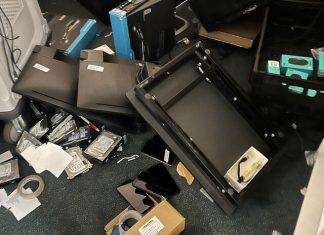AN award-winning Aboriginal artist is showcasing her work at an exhibition exploring indigenous cultural and political issues.
Inspired by the works of her Aboriginal grandmother, who was a landscape artist, Footscray artist Paola Balla knew from childhood she was destined to spend her life creating art.
“My grandmother was my first teacher and she inspired me in how to look and see things in the world,” she says.
Balla says she draws on her heritage and family for inspiration to explore identity, belonging and justice for indigenous Australians.
The Wemba-Wemba and Gunditjmara descendant is one of 10 artists showcasing their work at an exhibition in Moonee Ponds.
The exhibition represents a range of urban-based indigenous artists, exploring their unique personal, political and cultural issues in a provocative, often humorous way.
Balla says that while her artwork often incorporates elements of satire and popular culture, the message is poignant.
She adds that the exhibition’s artists are educated and opinionated, and have political statements to make.
“Aboriginal artists are often overlooked and our voices aren’t heard because we often don’t look Aboriginal enough,” she says.
“These exhibitions are really vital because they give us a voice we can share with an audience to stimulate a lot of really important debate and dialogue about Australia’s colonisation, and the cultural and social life in Australia.”
Balla says each of the 20 objects that make up her three-dimensional art display have been carefully selected and are dear to her.
A bottle of dirt with a sailing ship inside depicts Australian colonisation.
A ledger is inscribed with the words, ‘‘I know what you did last century’’.
And statues of babies half-dipped in sugar portray the high rates of diabetes among indigenous Australians following the influx of processed foods.
“There is also kitchen flour, one of the items used as part of the John Batman Treaty in Melbourne in 1835,” Balla says. “Flour is very symbolic in a number of ways, as it is a symbol of Aboriginal women using it to make damper to get their family through hard times and poverty.
“But it also represents many of the untold traumatic stories of the occupation of this country, including how it was often poisoned before being given to indigenous people.” Balla has also used the flour to draw a crucifix to comment on the missionaries who attempted to convert Aborigines to Christianity.
In 2011, Balla won an award for her three-dimensional work in the 2011 Victorian Indigenous Art Awards.
She divides her time between her roles as indigenous studies lecturer at Victoria University, indigenous activist and community arts practitioner.
Indigenous Voices, Contemporary Strategies is at the Incinerator Gallery, 180 Holmes Road, Moonee Ponds, until September 15.
Details: 8325 1750 or incineratorgallery.com








